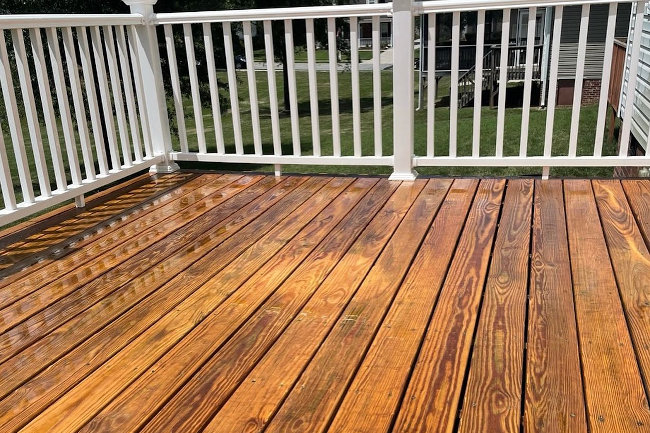Picking the Right Discoloration for Your Fencing: Tips and Factors To Consider
When it comes to boosting the look and preserving of your fencing, selecting the appropriate stain is crucial. We will discover the various kinds of fencing spots, aspects to consider prior to selecting a tarnish, tips for preparing your fencing for staining, and the differences in between water-based and oil-based spots. In addition, we will delve into picking the right tarnish shade to enhance your fence and boost your exterior room.
Understanding Various Kinds Of Fence Spots

On the other hand, water-based discolorations are made from acrylic or latex and provide a much more refined shade to the timber. Water-based spots are much easier to clean up and have a faster drying out time compared to oil-based stains.
Choosing between oil-based and water-based discolorations depends on numerous variables, including individual choice, the wanted appearance, and the level of upkeep needed. Oil-based discolorations are recommended for fencings in high-traffic locations or those constantly subjected to extreme weather. fence staining and sealing. Water-based discolorations, on the other hand, are a preferred option for fences in suburbs where appearance and ease of use are essential
When choosing the appropriate tarnish for their fencing,Understanding the differences between water-based and oil-based stains helps house owners make an educated choice. Thinking about the specific requirements of the fence, such as its area, exposure to sunshine, and desired visual, will certainly guarantee that the picked tarnish supplies resilient defense and boosts the total charm of the fencing.
Aspects to Take Into Consideration Prior To Selecting a Discoloration

Another factor to take into consideration is the sort of timber your fence is constructed from. Various types of wood take in discolorations in different ways, leading to varying degrees of color intensity and durability. For example, softwoods like yearn might call for even more constant discoloration contrasted to hardwoods like cedar or redwood. In addition, certain woods might be much more vulnerable to problems like rot or insect infestation, which might affect the choice of discolor to protect the fencing and safeguard.
The climate and climate problems in your location need to additionally be considered. You may need a discolor that gives added security against moisture and UV rays if you live in an area with rough wintertimes or high moisture. If your fence is revealed to guide sunlight for lengthy periods, a tarnish with UV inhibitors can aid protect against fading and staining.
Lastly, it is essential to consider your desired visual. Various discolorations supply different shades and finishes, permitting you to tailor the appearance of your fencing (fence staining). Consider the total style and style of your building, along with any kind of local guidelines or homeowner association standards that might determine the appropriate stain shades
Tips for Preparing Your Fence for Discoloration
To prepare your fence for staining, begin by completely cleaning up the surface area making use of a light detergent and a pressure washing machine or scrub brush. Cleaning the fence is an important action as it eliminates dirt, grime, and any previous coatings that may hinder the staining process. Begin by moistening the fencing with water and afterwards apply a mild cleaning agent utilizing a scrub brush or a stress washer with a low-pressure setting. Rub the surface area carefully, paying added attention to areas with stubborn discolorations or mold and mildew. Wash the fence completely with tidy water to get rid of all traces of detergent.
This step is vital as staining a moist or wet surface can lead to poor attachment and an irregular coating. Guarantee that the fencing is totally dry before continuing with the discoloration procedure.
Before discoloration, inspect the fence for any kind of damages, such as loose boards or nails. Repair any kind of concerns to make sure that the fence is structurally sound. In addition, consider applying a timber conditioner or brightener to the surface area. This product helps to open the timber pores, enabling the discolor to pass through a lot more efficiently and uniformly.

Comparing Oil-Based and Water-Based Spots
When picking a tarnish for your fence, it is very important to compare the characteristics and advantages of oil-based and water-based discolorations. Both kinds of discolorations have their very own advantages and factors to consider, so it is vital to recognize the distinctions in between them.
Oil-based discolorations are known for their toughness and resistance to tear and wear. In addition, oil-based discolorations have a tendency to last longer than water-based spots, making them a prominent option for fencings.
On the other hand, water-based discolorations are extra eco friendly and simpler to clean up. They may not provide the exact same degree of defense as oil-based discolorations, especially in extreme climate conditions.
Ultimately, the choice in between water-based and oil-based stains relies on your specific demands and preferences. When making your choice, think about aspects such as sturdiness, ecological influence, and ease of application. Consulting with a professional or seeking suggestions from specialists can additionally aid make certain that you select the right tarnish for your fence.
Picking the Right Spot Shade for Your Fencing
The choice of a suitable stain shade for your fence is a crucial element of boosting its aesthetic appeal and complementing the total style of your exterior room (deck cleaning). The best tarnish shade can change a plain, regular fencing into a striking focal point that adds depth and personality to your home
When visit here selecting a stain shade for your fence, it is essential to think about the design and architecture of your home. Earthy tones such as browns and neutrals can create a warm and inviting appearance if you have a traditional or conventional style home. On the various other hand, if you have a contemporary or contemporary home, you could think about selecting vibrant and vivid shades that make a statement.
An additional variable to take into consideration is the natural environments of your residential or commercial property. If you have a lot of greenery, a tarnish shade that matches the natural landscape, such as eco-friendlies or crimsons, can develop a harmonious and cohesive appearance.
Additionally, it deserves taking into consideration the maintenance required for various tarnish shades. Lighter colors have a tendency to reveal dust and put on more conveniently, while darker shades can conceal flaws and call for much less regular touch-ups.
Ultimately, the selection of discolor color for your fence need to mirror your individual design and preferences - fence staining companies. Make the effort to explore various options and seek advice from with experts if required, to make certain that you pick the excellent tarnish color that improves the charm and appeal of your fence
Final Thought
In verdict, when it involves picking the ideal stain for your fencing, it is crucial to comprehend the different kinds of spots offered and take into consideration variables such as toughness and wanted appearance. Preparing the fencing effectively before staining is essential for attaining optimal results. Additionally, contrasting oil-based and water-based discolorations can help figure out the best choice for your certain needs. Picking the right stain shade can enhance the general looks of your fence.
We will discover the various kinds of fence spots, aspects to consider prior to selecting a discolor, tips for preparing your fence for staining, and the differences between oil-based and water-based spots.Distinguishing in between oil-based and water-based discolorations is important when comprehending various kinds of fence spots. Water-based spots are simpler to cleanse up and have a quicker drying out time compared to oil-based spots. Additionally, oil-based stains tend to last longer than water-based spots, making them a prominent option for fencings.
In verdict, when it comes to selecting the ideal discolor for your fence, it is vital to recognize the different kinds of spots readily available and consider aspects such as resilience and desired look.